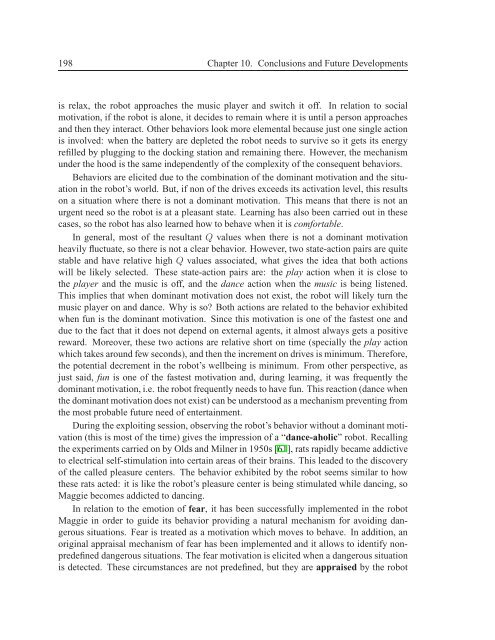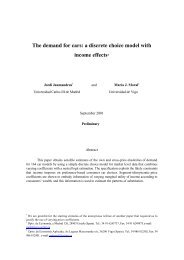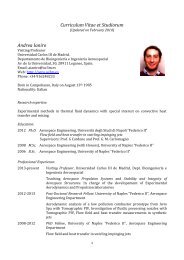TESIS DOCTORAL - Robotics Lab - Universidad Carlos III de Madrid
TESIS DOCTORAL - Robotics Lab - Universidad Carlos III de Madrid
TESIS DOCTORAL - Robotics Lab - Universidad Carlos III de Madrid
Create successful ePaper yourself
Turn your PDF publications into a flip-book with our unique Google optimized e-Paper software.
198 Chapter 10. Conclusions and Future Developmentsis relax, the robot approaches the music player and switch it off. In relation to socialmotivation, if the robot is alone, it <strong>de</strong>ci<strong>de</strong>s to remain where it is until a person approachesand then they interact. Other behaviors look more elemental because just one single actionis involved: when the battery are <strong>de</strong>pleted the robot needs to survive so it gets its energyrefilled by plugging to the docking station and remaining there. However, the mechanismun<strong>de</strong>r the hood is the same in<strong>de</strong>pen<strong>de</strong>ntly of the complexity of the consequent behaviors.Behaviors are elicited due to the combination of the dominant motivation and the situationin the robot’s world. But, if non of the drives exceeds its activation level, this resultson a situation where there is not a dominant motivation. This means that there is not anurgent need so the robot is at a pleasant state. Learning has also been carried out in thesecases, so the robot has also learned how to behave when it is comfortable.In general, most of the resultant Q values when there is not a dominant motivationheavily fluctuate, so there is not a clear behavior. However, two state-action pairs are quitestable and have relative high Q values associated, what gives the i<strong>de</strong>a that both actionswill be likely selected. These state-action pairs are: the play action when it is close tothe player and the music is off, and the dance action when the music is being listened.This implies that when dominant motivation does not exist, the robot will likely turn themusic player on and dance. Why is so? Both actions are related to the behavior exhibitedwhen fun is the dominant motivation. Since this motivation is one of the fastest one anddue to the fact that it does not <strong>de</strong>pend on external agents, it almost always gets a positivereward. Moreover, these two actions are relative short on time (specially the play actionwhich takes around few seconds), and then the increment on drives is minimum. Therefore,the potential <strong>de</strong>crement in the robot’s wellbeing is minimum. From other perspective, asjust said, fun is one of the fastest motivation and, during learning, it was frequently thedominant motivation, i.e. the robot frequently needs to have fun. This reaction (dance whenthe dominant motivation does not exist) can be un<strong>de</strong>rstood as a mechanism preventing fromthe most probable future need of entertainment.During the exploiting session, observing the robot’s behavior without a dominant motivation(this is most of the time) gives the impression of a “dance-aholic” robot. Recallingthe experiments carried on by Olds and Milner in 1950s [61], rats rapidly became addictiveto electrical self-stimulation into certain areas of their brains. This lea<strong>de</strong>d to the discoveryof the called pleasure centers. The behavior exhibited by the robot seems similar to howthese rats acted: it is like the robot’s pleasure center is being stimulated while dancing, soMaggie becomes addicted to dancing.In relation to the emotion of fear, it has been successfully implemented in the robotMaggie in or<strong>de</strong>r to gui<strong>de</strong> its behavior providing a natural mechanism for avoiding dangeroussituations. Fear is treated as a motivation which moves to behave. In addition, anoriginal appraisal mechanism of fear has been implemented and it allows to i<strong>de</strong>ntify nonpre<strong>de</strong>fineddangerous situations. The fear motivation is elicited when a dangerous situationis <strong>de</strong>tected. These circumstances are not pre<strong>de</strong>fined, but they are appraised by the robot






